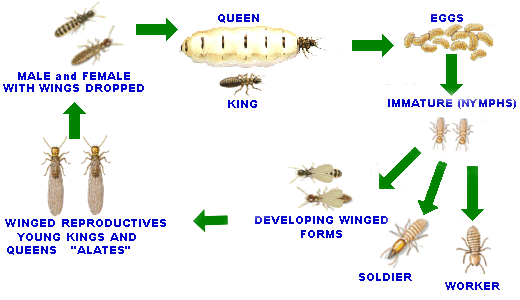Area of Distribution: The Western drywood termite is found in the southwestern
states, as far north as Sacramento, with heavier incidence along the
coastal areas.
The Western drywood termite accounts for most of the drywood termite
damage in southern California.
Colonies contain up to about 2,000 termites. Severe damage may be caused
by the presence of multiple-colonies.It is easily transported outside
these areas in infested furniture and other timbers. This termite lives
in timber with moisture content of less than 12%.
Drywood termites are often distributed by human activity, commonly by
transporting infested furniture, picture frames, and wood to new areas.
It has failed to become established in such areas outside its normal
southern and mostly coastal range.
Identification of Swarmers and Soldiers: Swarmers are about 1/2"
long including wings Their wings are 3/8" long. The head and pronotum
of the swarmer is an orange brown and its abdomen is dark brown. The
front wing has 3 dark, heavily hardened veins in the front portion.
The forehead of the soldier slopes down gradually from top of head,
head flattened to slightly rounded in side view, and head orange to
reddish brown with the eye spot whitish. Soldiers have mandibles with
unequal number of teeth on each member of pair, and antenna with the
third segment greatly enlarged and club-like.
Identification of Timber Damage: Although the colony development is
slow, severe structural damage may still be caused by the presence of
multiple-colonies. Drywood termites eat across the wood grain and create
chambers, or galleries connected by tunnels.
Their gallery and tunnel walls are velvety smooth, and no soil is present.
Generally, there are faecal pellets present. They are hard, less than
1/32" long, elongate-oval with rounded ends. One of the unusual
distinctive signs of their faecal pellets is that they have 6 concave
sides.
Evidence of infestation include swarmers, shed wings, piles of pellets,
termite plugs that seal all openings in infested wood, and surface blisters
caused by older, enlarged galleries very close to the wood surface.
Biology and Habits: Drywood termites are considered non-subterranean
termites, as they do not live in the ground, require no ground contact,
and do not build mud shelter tubes.
They are more likely to be in a structure made completely of wood with
poor workmanship demonstrated by poorly fitted corner joints. The termites
typically inter the ends of wood and seldom enter the sides of the section
in question.
Their colonies are located in the wood they eat and are generally small
in size when compared to subterranean termite colonies. The colony usually
numbers about 3,000 individuals after over 10 to15 years. A distinctive
indication is no presence of a worker caste and the nymphs perform all
tasks typically done by workers.
After the mating flight, they seek cracks or knotholes in nearby wood
and chew a small tunnel which they close then excavating a chamber after
which they mate. After 3 year to 4 years the colony may consist of up
to 1,000 members.
The first swarmers may be released when the colony is approximately
4 years old. Swarming typically takes place about midday on sunny, warm
(80°F) days, with the peak of the swarm occurring shortly after
a sudden rise in temperature. It typically occurs during September and
October. Swarmers usually number in the dozens, occasionally the hundreds.
Night swarmers are attracted to lights.
Swarming drywood termites fly into structures and infest wood directly.
When swarming, they often reinfest the same structure. They typically
first infest exposed wood such as window/door frames, trim, eaves and
attics. They do so by finding a protected crevice or other area, such
as the joint between 2 pieces of wood, where shingles/paper overhang
timber or moulding, etc., and then attack the wood.










